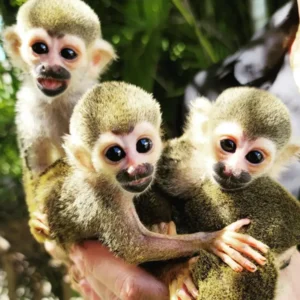Spider Monkeys
$1,700.00 – $3,099.00
| Attribute | Details |
|---|
| Breed | Spider Monkeys |
| Age | 14 weeks |
| Sex | Male/Female |
| Vaccination | Up to Date |
| Health Guarantee | One Year Genetic Health Guarantee |
🐒 About Spider Monkeys
Spider monkeys are large, long-limbed primates known for their incredible agility and long, prehensile tails. They are one of the most intelligent New World monkeys and are native to the rainforests of Central and South America.
📊 Spider Monkey Facts Table
| Category | Details |
|---|---|
| Common Name | Spider Monkey |
| Scientific Name | Ateles spp. |
| Origin | Central & South America |
| Lifespan | 20–27 years (wild), up to 40 years (captivity) |
| Size | 16–24 inches (body), tail can be up to 35 inches |
| Weight | 15–20 pounds (6.8–9 kg) |
| Tail Type | Long, prehensile (used like a 5th limb) |
| Diet | Primarily frugivorous (fruit-based) with leaves and seeds |
| Temperament | Social, vocal, intelligent, can be temperamental |
| Habitat | Tropical rainforests, high canopy levels |
| Social Behavior | Lives in troops of 15–30, highly cooperative |
| Vocalizations | Screams, whinnies, barks, grunts |
| Legal to Own? | Highly restricted in many places; permits required |
❓ General FAQs About Spider Monkeys
Q1: Why are they called spider monkeys?
👉 Because of their long limbs and tail that resemble a spider when they hang or swing in trees.
Q2: Are spider monkeys good pets?
👉 Generally, no. They are wild animals that need lots of space, mental stimulation, and social interaction. Keeping them as pets can lead to aggression, stress, and health problems for the monkey.
Q3: What do spider monkeys eat?
👉 Mostly fruit, but also leaves, flowers, nuts, and occasionally insects or eggs.
Q4: Are spider monkeys endangered?
👉 Yes. Due to deforestation and hunting, some species of spider monkeys are listed as endangered or critically endangered.
Q5: How do spider monkeys move?
👉 With incredible agility, using their prehensile tail and limbs to swing and climb through the forest canopy.
🤪 Fun FAQs About Spider Monkeys
Q1: Can a spider monkey hang by its tail?
👉 Yes! Their tail is like an extra arm, strong enough to hold their entire body weight.
Q2: Do spider monkeys use tools?
👉 Not as much as capuchins, but some have been observed using leaves as cups or scratching sticks.
Q3: Are they loud?
👉 Very! They use loud whoops and howls to communicate over long distances.
Q4: Do they have thumbs?
👉 No! Spider monkeys lack a true thumb. This actually helps them swing better in the trees.
Q5: Do spider monkeys form friendships?
👉 Yes. They show affection by grooming, hugging, and playing — very social animals.
🩺 How to Treat and Care for Spider Monkeys (If Legally Permitted)
💚 Habitat
-
Huge enclosures needed (minimum 10x10x10 feet, ideally with tree access).
-
Vertical climbing space is crucial; ropes, branches, platforms, and swings.
-
Warm, humid environment — they’re tropical forest dwellers.
🥗 Diet
-
Primarily fruits (banana, mango, papaya)
-
Leafy greens and soft leaves
-
Nuts, seeds, flowers, bark
-
Occasional protein (insects, cooked eggs)
-
Fresh, clean water available at all times
🧠 Enrichment
-
Mental stimulation daily with puzzles, mirrors, and changing toys.
-
Human interaction or other monkey companions to prevent boredom and depression.
👩⚕️ Medical Care
-
Requires an exotic veterinarian experienced in primates.
-
Regular checkups, dental care, parasite screenings.
-
Vaccinations may be required depending on local laws.
🧼 Cleanliness & Hygiene
-
Clean living space daily
-
Proper sanitation of food and water containers
-
Tail and limb checks for injuries from climbing equipment
🚫 What Not to Do
-
❌ Do not keep them in small cages.
-
❌ Do not isolate them — spider monkeys are highly social.
-
❌ Avoid sugary, salty, or processed foods.
-
❌ Don’t treat them as domestic pets — they’re complex, wild primates.








Reviews
There are no reviews yet.